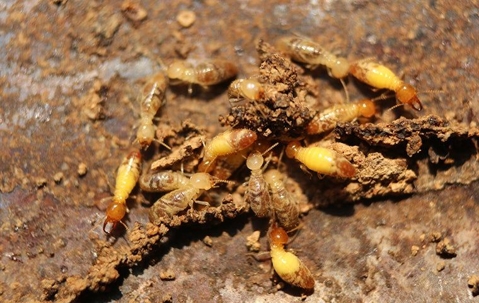Is this a sign of ants or a sign of termites? Is that a mud blob or a termite carton? Why is dirt coming out of the wall outlet? Many people have asked us questions like these concerning termites, and any concerned homeowner should. A Texas A&M statistic states that “there are 10 -18 separate colonies of termites for every acre.” Yikes! So how do you know if you have termites chewing on your house?
Whether your house is new or old, small or worth a million bucks, when it comes down to it, termites are just hungry. They are always looking for food and water. Water is found plentifully in the ground as rainwater seeps into the soil, and groundwater levels provide a constant drinking supply. Termites have a special diet of cellulose, which is found in the most common building material in residential houses, wood. Thus a termite sees your house as a very appetizing buffet of studs, sheathing, and beams. Let's begin by exploring how termites can get into your home.
The most common types of termites in Texas are subterranean termites, meaning they live in the ground. There they collect their moisture and then tunnel around, looking for a food source. Often dead trees, roots, raw mulch, and buried building materials found throughout neighborhoods are found as deciduous delicacies. As termite workers meet the foundation of houses, they build tubes of soil and frass against the foundation to protect themselves as they venture above the ground. Depending on the construction of the home, they can find access to walls through weep holes (brick facade) or under the siding (stucco or siding facade). For this reason, we ask our clients to maintain 1 to 2 inches of visibility of the foundation under the siding around the structure. This, in turn, assists us in detecting termite colonies seeking entrance into the walls of your home.
Eager to find a meal, termites will also tunnel further underneath homes looking for any gap or crack that may allow access. Termites can start with a 1/64-inch crack and make their way into our home. To put that into perspective, that is the width of a hair! Such areas may be cracks that have formed in the foundation, expansion joints, and pipe penetrations in areas such as first-floor bathrooms, laundry rooms, and sinks.
Once they are inside a home, it is difficult to detect termites if you don’t have special detection equipment. Inside the walls, they will continue to eat and tunnel, causing damage to wooden framing and structural members. Some species of subterranean termites, Formosan termites, are capable of eating through one foot of 2X4 wood in 25 days. This can cause wood trim to sound hollow and wood flooring to get soft. In time, termites will eat away while following a natural instinct to climb upward continuously. As they continue eating and tunneling, they may occasionally punch out through sheetrock or wall material. These holes look similar to holes left by nails used to hang picture frames. Drywood termites use these openings as kick-out openings to expel soil and frass.
As a termite colony establishes itself, it will produce a reproductive termite called an Alate that will leave the colony to start additional colonies. Because these Alates (or winged termites) are terrible fliers, they must use height as an advantage to cover greater distances. As these termites climb to the top reaches of the colony (in a home, this may be the top of studs, window sills, etc.), they will fall with style out of holes in walls, trees, bushes, or the ground to find a mate and start a colony of their own. Depending on the species, these fliers will appear in masses during the spring or fall, night or day, often a couple of days after a rain event. If these fliers are found in or near your house, then you know you have or will have a problem!
In summary:
- Tubes of soil at the foundation of the house.
- Termite activity found in any penetration through the concrete slab.
- Damaged wood; trim, window frames, flooring, etc.
- Small “kick-out holes” are found in the walls.
- Termite Alates or “fliers” are found in and around the house.
This is a first-glance, basic list of what homeowners should look for if they think they have termites. If any of these conditions are experienced, then give your Green Pest Guys a call! We do not want the problem to get worse. The first step in solving a termite problem is the proper assessment of termite activity and identification of the termite species. Our trained professionals will inspect your home and work through a plan for eco-friendly pest control to safely and effectively manage the termites from your home. If you don’t see any of these conditions yet, Great! Preventive treatment is always a great starting point to keep your house termite free! We would be happy to give you more information. Give us a call!

